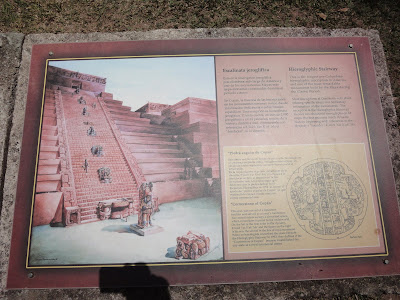 David sorted the paperwork on the Guatemalan side: Exit from Guatemala in our passports and temporary exportation of Nancy. On the Honduras side, after paying $3 USD each for entry, we were told it would be $35 USD to take the bike into Honduras for a day or for 90 days, and as we were only going in for the day decided to leave Nancy at the border under the eye of a security guard with a gun and get the bus to Copán Ruinas for $1 USD each just 7kms away.
David sorted the paperwork on the Guatemalan side: Exit from Guatemala in our passports and temporary exportation of Nancy. On the Honduras side, after paying $3 USD each for entry, we were told it would be $35 USD to take the bike into Honduras for a day or for 90 days, and as we were only going in for the day decided to leave Nancy at the border under the eye of a security guard with a gun and get the bus to Copán Ruinas for $1 USD each just 7kms away.On arrival at the town of Copán Ruinas, a very pleasant cobble street town
 with a spacious town square,
with a spacious town square,  we headed for a café for a croissant and coffee before going to the ruins. Usually in such places there are no refreshments inside, though usually stall selling drinks and souvenirs outside. It is strange still seeing men with large guns guarding shops, and banks. Check this one out through the window.
we headed for a café for a croissant and coffee before going to the ruins. Usually in such places there are no refreshments inside, though usually stall selling drinks and souvenirs outside. It is strange still seeing men with large guns guarding shops, and banks. Check this one out through the window.  Once at Copan
Once at Copan  we paid our $15 USD each entry, and were greeted by a parrot, a riot of colour amongst the green trees.
we paid our $15 USD each entry, and were greeted by a parrot, a riot of colour amongst the green trees. 
Then off to visit the ruins. We had been offered a tour guide for $25 USD but thought this was a bit pricey so wandered around trying to make sense of it all ourselves with the help of our guide book.
We began with some Stela's the carving of which is amazing even fifteen hundred + years after completion

 alter pieces,
alter pieces, 
 animal like thingies,
animal like thingies, 

 The Ball court
The Ball court 
 (ball games were a ritual once upon a time) the looser often lost not only the game but also his life sometimes.
(ball games were a ritual once upon a time) the looser often lost not only the game but also his life sometimes. The hieroglyphic stairway



which is now covered as the wind and rain have caused so much damage. This a an impression of what it may have looked like.
 Heads
Heads 
 and the sacred Jaguar,
and the sacred Jaguar,  looking over the Jaguar court.
looking over the Jaguar court.  Rocks upon rocks.
Rocks upon rocks.  In fact the site was quite flat and everything has been built up from rocks,
In fact the site was quite flat and everything has been built up from rocks, 
 overlaid with smooth and carved rock.
overlaid with smooth and carved rock. 
 The area at the rear of the main complex known as 'the cemetery' was very peaceful,
The area at the rear of the main complex known as 'the cemetery' was very peaceful, 
 and housed the elite of Copan.
and housed the elite of Copan. There were animals,


 and magnificent trees
and magnificent trees 

 all adding to the magic.
all adding to the magic.In 760AD when these structures were being completed, Alfred the Great of Wessex (later to become England) was hiding out in the Somerset marshes while the Danes plundered. It would seem that the Mayan great cities fell into disuse due to over-population and overuse of the finite resources that were around at that time along with drought. Have we learnt anything from their example?
We left the site and retraced our steps back to Copan Ruinas and the bus to the border where we paid another $3 USD each to exit Honduras and Q10 to get back into Guatemala. Nancy was imported back into Guatemala without any fuss and we had a lovely ride back to the Hotel Hernandez in Chiquimula.
No comments:
Post a Comment